HONDA PRELUDE 1992 Owners Manual
Manufacturer: HONDA, Model Year: 1992, Model line: PRELUDE, Model: HONDA PRELUDE 1992Pages: 225, PDF Size: 2.1 MB
Page 171 of 225
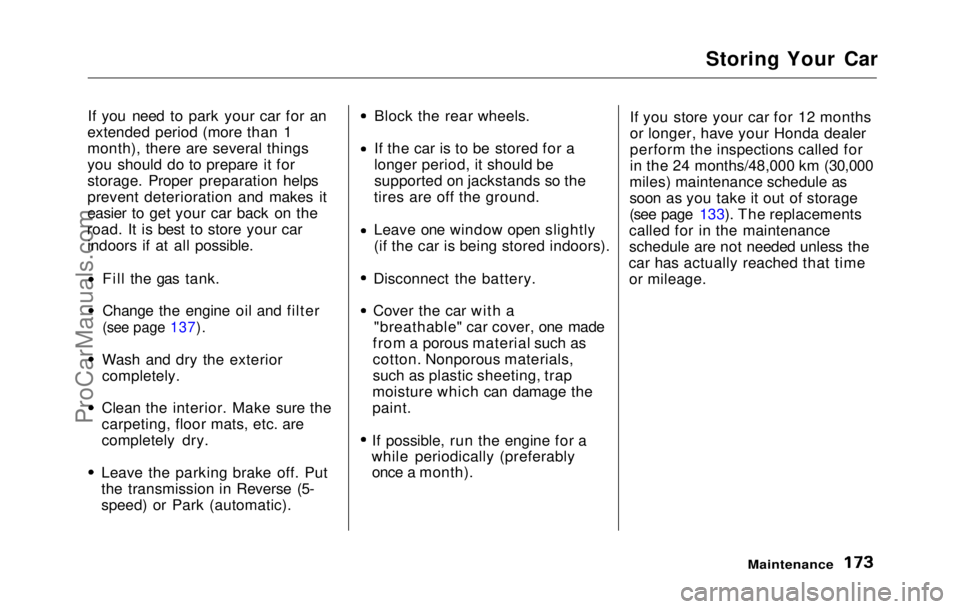
Storing Your Car
If you need to park your car for an
extended period (more than 1
month), there are several things
you should do to prepare it for
storage. Proper preparation helps
prevent deterioration and makes it
easier to get your car back on the
road. It is best to store your car indoors if at all possible. Fill the gas tank.
Change the engine oil and filter
(see page 137).
Wash and dry the exterior
completely.
Clean the interior. Make sure the
carpeting, floor mats, etc. are
completely dry.
Leave the parking brake off. Put
the transmission in Reverse (5-
speed) or Park (automatic). Block the rear wheels.
If the car is to be stored for a
longer period, it should be
supported on jackstands so the
tires are off the ground.
Leave one window open slightly
(if the car is being stored indoors).
Disconnect the battery.
Cover the car with a "breathable" car cover, one made
from a porous material such as
cotton. Nonporous materials,
such as plastic sheeting, trap
moisture which can damage the
paint. If possible, run the engine for a
while periodically (preferably once a month). If you store your car for 12 months
or longer, have your Honda dealer
perform the inspections called for
in the 24 months/48,000 km (30,000
miles) maintenance schedule as
soon as you take it out of storage
(see page 133). The replacements
called for in the maintenance
schedule are not needed unless the
car has actually reached that time or mileage.
MaintenanceProCarManuals.comMain Menu Table of Contents s t
Page 172 of 225

Appearance Care
Regular cleaning and polishing of
your Honda helps to keep it "new"
looking. This section gives you
hints on how to clean and preserve
your car's appearance: the paint,
brightwork, wheels and interior. Also included are several things
you can do to help prevent corro-
sion.
Exterior Care................................ 176 Washing..................................... 176
Waxing....................................... 177
Aluminum Wheels................... 177
Paint Touch-up......................... 178
Interior Care.................................. 179 Carpeting................................... 179
Fabric........................................ 179
Vinyl........................................... 179
Seat Belts.................................. 179
Windows..................................... 180
Air Fresheners.......................... 180
Corrosion Protection................... 180
Body Repairs................................. 181
Appearance CareProCarManuals.comMain Menu s t
Page 173 of 225
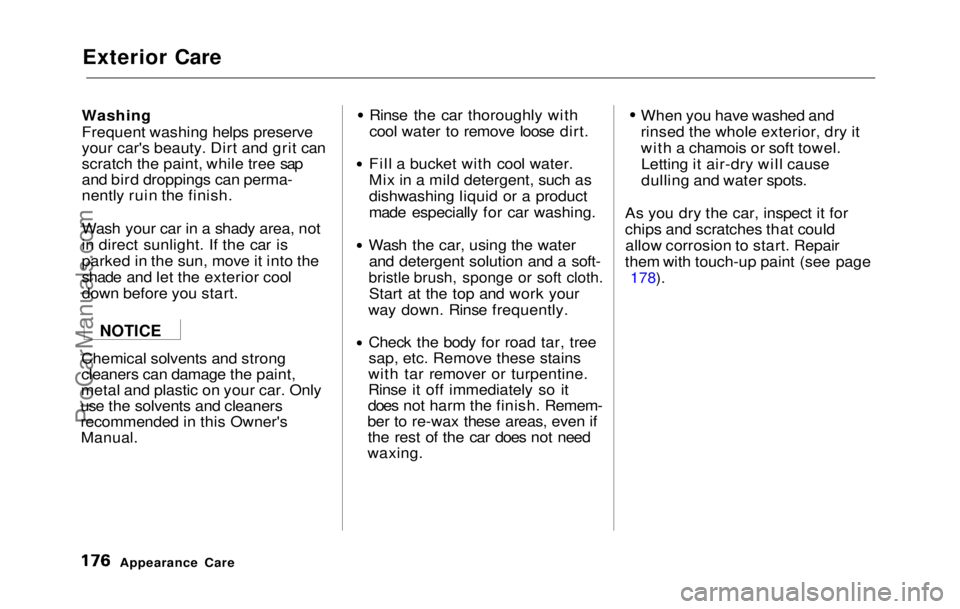
Exterior Care
Washing
Frequent washing helps preserve
your car's beauty. Dirt and grit can
scratch the paint, while tree sap
and bird droppings can perma-
nently ruin the finish.
Wash your car in a shady area, not
in direct sunlight. If the car is
parked in the sun, move it into the
shade and let the exterior cool
down before you start.
Chemical solvents and strong
cleaners can damage the paint,
metal and plastic on your car. Only
use the solvents and cleaners
recommended in this Owner's
Manual.
Rinse the car thoroughly with
cool water to remove loose dirt.
Fill a bucket with cool water.
Mix in a mild detergent, such as
dishwashing liquid or a product
made especially for car washing.
Wash the car, using the water and detergent solution and a soft-bristle brush, sponge or soft cloth.
Start at
the top and work your
way down. Rinse frequently.
Check the body for road tar, tree
sap, etc. Remove these stains
with tar remover or turpentine.
Rinse it off immediately so it
does not harm the finish. Remem-
ber to re-wax these areas, even if the rest of the car does not need
waxing. When you have washed and
rinsed the whole exterior, dry it
with a chamois or soft towel.
Letting it air-dry will cause
dulling and water spots.
As you dry the car, inspect it for
chips and scratches that could allow corrosion to start. Repair
them with touch-up paint (see page
178).
Appearance Care
NOTICEProCarManuals.comMain Menu Table of Contents s t
Page 174 of 225

Exterior Care
Waxing
Always wash and dry the whole car
before waxing it. You should wax your car, including the metal trim,
whenever water sits on the surface in large patches. It should form into
beads or droplets after waxing.
You should use a quality liquid orpaste wax. Apply it according to
the instructions on the container. In
general, there are two types of products:
Waxes — A wax coats the finish and protects it from damage by
exposure to sunlight, air pollution,
etc. You should use a wax on yourHonda when it is new.
Polishes — Polishes and cleaner/
waxes can restore the shine to
paint that has oxidized and lost
some of its shine. They normally
contain mild abrasives and solvents
that remove the top
layer of the
finish. You should use a polish on
your Honda if the finish does not
have its original shine after using a
wax.
Cleaning tar, insects, etc.
with
removers also takes off the wax.
Remember to re-wax those areas,
even if the rest of the car does not
need waxing.
Aluminum
Wheel
s
Clean your Honda's aluminum alloy
wheels as you do the rest of the exterior. Wash them with the same
solution, and rinse them thoroughly.
The wheels have a protective clear-
coat that keeps the aluminum from
corroding and tarnishing. Using
harsh chemicals, including some
commercial wheel cleaners, or stiff
brushes can damage this clear-coat.
Only use a mild detergent and soft
brush or sponge to clean the wheels.
Appearance CareProCarManuals.comMain Menu Table of Contents s t
Page 175 of 225
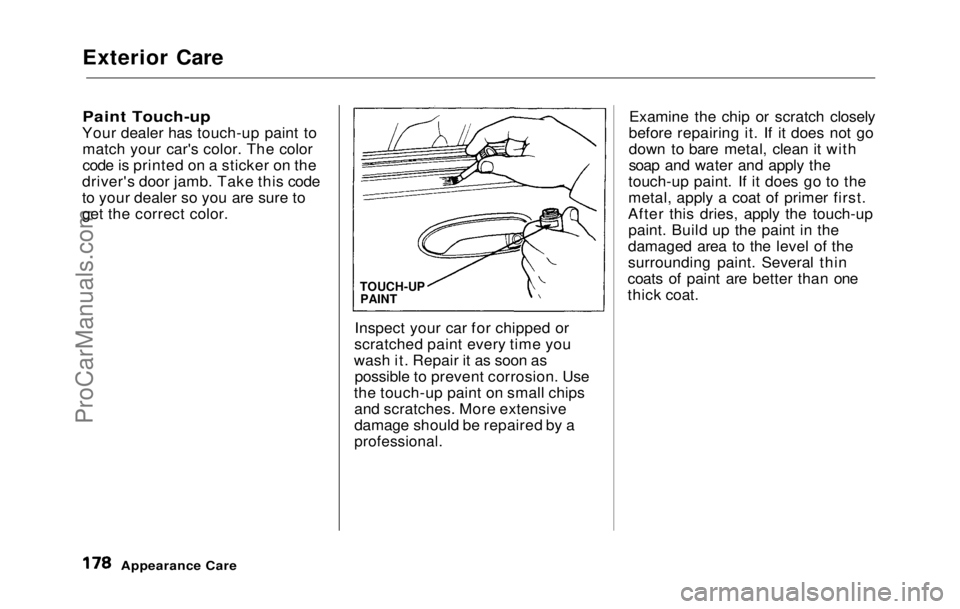
Exterior Care
Paint Touch-up
Your dealer has touch-up paint to match your car's color. The color
code is printed on a sticker on the
driver's door jamb. Take this code
to your dealer so you are sure to
get the correct color.
Inspect your car for chipped or
scratched paint every time you
wash it. Repair it as soon as possible to prevent corrosion. Use
the touch-up paint on small chips and scratches. More extensive
damage should be repaired by a
professional.
Examine the chip or scratch closely
before repairing it. If it does not go
down to bare metal, clean it with
soap and water and apply the
touch-up paint. If it does go to the
metal, apply a coat of primer first.
After this dries, apply the touch-up paint. Build up the paint in the
damaged area to the level of the
surrounding paint. Several thin
coats of paint are better than one
thick coat.
Appearance Care
TOUCH-UP
PAINTProCarManuals.comMain Menu Table of Contents s t
Page 176 of 225
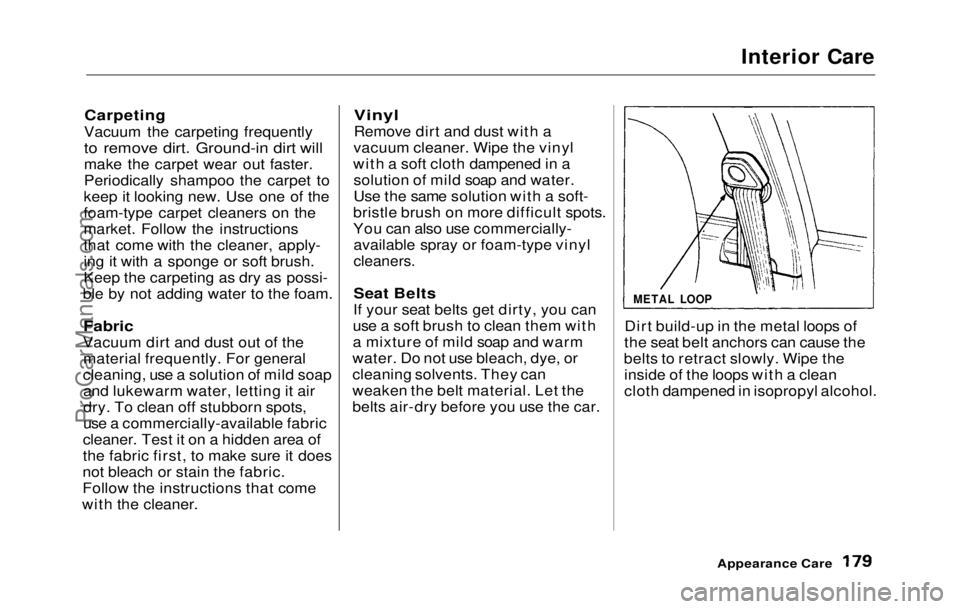
Interior Care
Carpeting
Vacuum the carpeting frequentlyto remove dirt. Ground-in dirt will
make the carpet wear
out faster.
Periodically shampoo the carpet to
keep it looking new. Use one of the
foam-type carpet cleaners on the
market. Follow the instructions
that come with the cleaner, apply-
ing it with a sponge or soft brush.
Keep the carpeting as dry as possi-
ble by not adding water to the foam.
Fabric
Vacuum dirt and dust out of the material frequently. For general
cleaning, use a solution of mild soap and lukewarm water, letting it air
dry. To clean off stubborn spots,
use a commercially-available fabric
cleaner. Test it on a hidden area of
the fabric first, to make sure it does
not bleach or stain the fabric.
Follow the instructions that come
with the cleaner.
Vinyl
Remove dirt and dust with a
vacuum cleaner. Wipe the vinyl
with a soft cloth dampened in a solution of mild soap and water.
Use the same solution with a soft-
bristle brush on more difficult spots.
You can also use commercially- available spray or foam-type vinyl
cleaners.
Seat Belts
If your seat belts get dirty, you can
use a soft brush to clean them with
a mixture of mild soap and warm
water. Do not use bleach, dye, or
cleaning solvents. They can
weaken the belt material. Let the
belts air-dry before you use the car. Dirt build-up in the metal loops of
the seat belt anchors can cause the
belts to retract slowly. Wipe the inside of the loops with a clean
cloth dampened in isopropyl alcohol.
Appearance Care
METAL LOOPProCarManuals.comMain Menu Table of Contents s t
Page 177 of 225
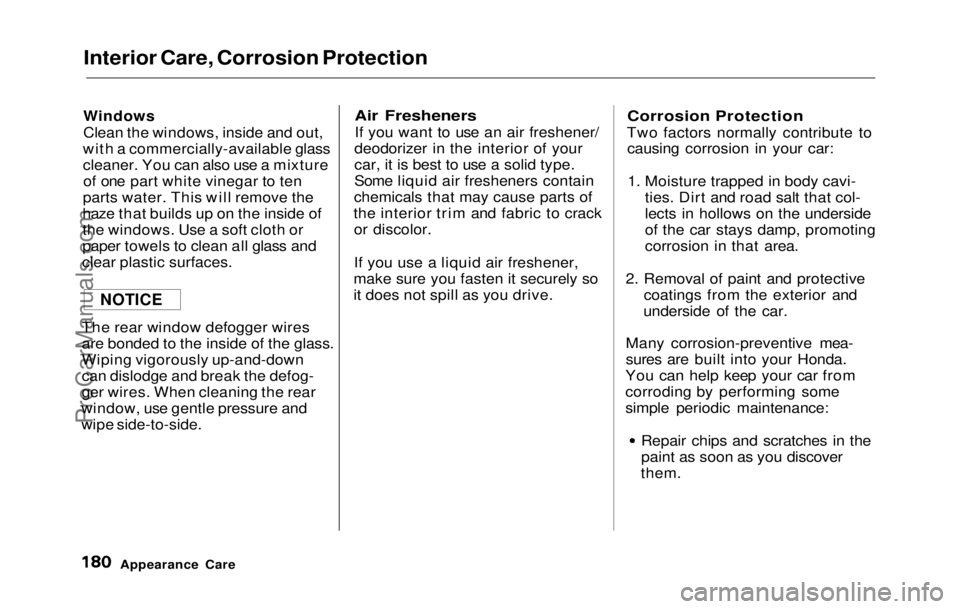
Interior Care, Corrosion Protection
Windows
Clean the windows, inside and out,
with a commercially-available glass
cleaner. You can also use a mixture of one part white vinegar to ten
parts water. This will remove the
haze that builds up on the inside of
the windows. Use a soft cloth or
paper towels to clean all glass and
clear plastic surfaces.
The rear window defogger wires
are bonded to the inside of the glass.
Wiping vigorously up-and-down
can dislodge and break the defog-
ger wires. When cleaning the rear
window, use gentle pressure and
wipe side-to-side.
Air Fresheners
If you want to use an air freshener/
deodorizer in the interior of your
car, it is best to use a solid type.
Some liquid air fresheners contain
chemicals that may cause parts of
the interior trim and fabric to crack or discolor.
If you use a liquid air freshener,
make sure you fasten it securely so
it does not spill as you drive.
Corrosion Protection
Two factors normally contribute to causing corrosion in your car:
1. Moisture trapped in body cavi-
ties. Dirt and road salt that col-
lects in hollows on th
e underside
of the car stays damp, promotin
g
corrosion in that area.
2. Remova l
of paint and protective
coatings from the exterior and
underside of the car.
Many corrosion-preventive mea
-
sures are built into your Honda.
You can help keep your car from
corroding by performing some
simple periodic maintenance: Repair chips and scratches in the
paint as soon as you discover
them.
Appearance Care
NOTICEProCarManuals.comMain Menu Table of Contents s t
Page 178 of 225

Corrosion Protection, Body Repairs
Inspect and clean out the drain
holes in the bottom of the doors
and body.
Check the floor coverings for
dampness. Carpeting and floor mats may remain damp for a long
time, especially in winter. This dampness can eventually cause
the floor panels to corrode.
Use a high-pressure spray to
clean the underside of your car.
This is especially important in
areas that use road salt in winter. It is also a good idea in humid
climates and areas subject to salt
air. Cars equipped with ABS
have a sensor and wiring at each
wheel. Be careful not to damage
them.
Have the corrosion-preventive
coatings on the underside of your
car inspected and repaired
periodically.
Body Repairs
Body repairs affect your car's
resistance to corrosion. If your car
needs repairs after a collision, pay
close attention to the parts used in
the repair and the quality of the
work.
Make sure the repair facility uses
genuine Honda replacement body
parts. Some companies make
sheetmetal pieces that seem to
duplicate the original Honda body parts, but are actually inferior in fit,
finish, and quality. Once installed,
they do not give the same high- quality appearance and level of
corrosion resistance. When reporting your collision to
the insurance company, tell them
you want genuine Honda parts
used in the repair. Although most insurers recognize the higherquality of original parts, some may
try to specify that the repairs be
done with the "lowest cost" parts
available. You should investigate
this before any repairs are begun.
Take your car to your authorized Honda dealer for inspection after
the repairs are completed. He can make sure that quality materials
were used, and that corrosion-
preventive coatings were applied to
all repaired and replaced parts.
Appearance Car e
ProCarManuals.comMain Menu Table of Contents s t
Page 179 of 225

Taking Care of the Unexpected
This section covers the more- common problems that motorists
experience with their cars. It gives
you information about how to
safely evaluate the problem and
what to do to correct it. If the problem has stranded you on the
side of the road, you may be able to
get going again. If not, you will also
find instructions on getting your
car towed. Compact Spare Tire..................... 184
Changing a Flat Tire................... 185
If Your Engine Won't Start........ 190 Nothing Happens...................... 190
The Starter OperatesNormally................................ 191
Jump Starting................................ 191 If Your Engine Overheats.......... 193
Low Oil Pressure.......................... 195
Charging System Indication ...... 196
Check Engine Light..................... 197
Closing the Sunroof ..................... 198
Fuses............................................... 199 Checking and Replacing.........
200
Towing...........................................
202
Taking Car e
of the UnexpectedProCarManuals.comMain Menu s t
Page 180 of 225
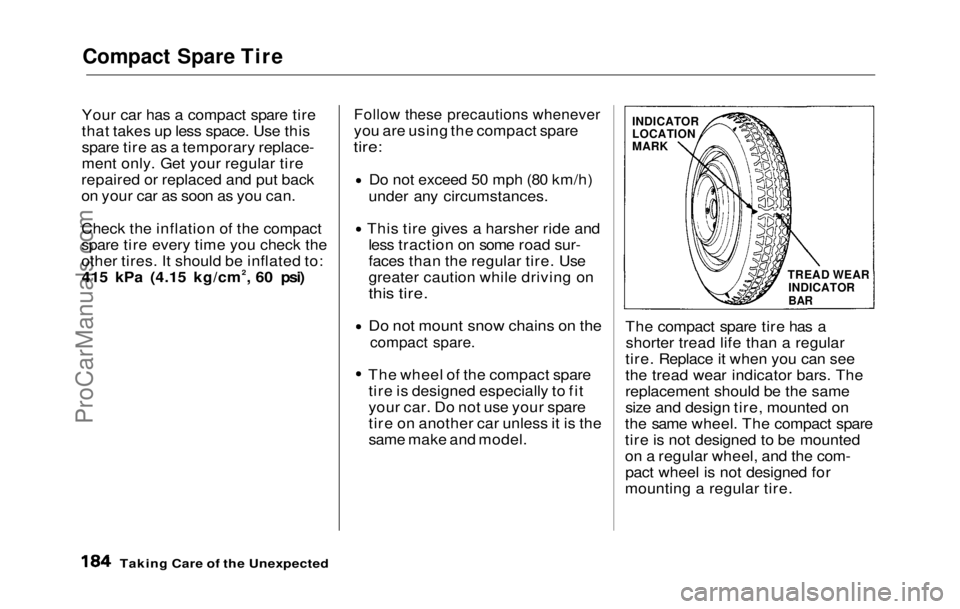
Compact Spare Tire
Your car has a compact spare tire
that takes up less space. Use this
spare tire as a temporary replace-
ment only. Get your regular tire
repaired or replaced and put back
on your car as soon as you can.
Check the inflation of the compact
spare tire every time you check the
other tires. It should be inflated to: 415 kPa (4.15 kg/cm2, 60 psi)
Follow these precautions whenever
you are using the compact spare
tire:
Do not exceed 50 mph (80 km/h)
under any circumstances. This tire gives a harsher ride and
less traction on some road sur-
faces than the regular tire. Use
greater caution while driving on
this tire.
Do not mount snow chains on the
compact spare.
The wheel
of the compact spare
tire is designed especially to fit
your car. Do not use your spare
tire on another car unless it is the
same make and model. The compact spare tire has a
shorter tread life than a regular
tire. Replace it when you can see
the tread wear indicator bars. The
replacement should be the same
size and design tire, mounted on
the same wheel. The compact spare
tire is not designed to be mounted
on a regular wheel, and the com- pact wheel is not designed for
mounting a regular tire.
Taking Care of the Unexpected
INDICATOR
LOCATION
MARK
TREAD WEARINDICATOR
BARProCarManuals.comMain Menu Table of Contents s t